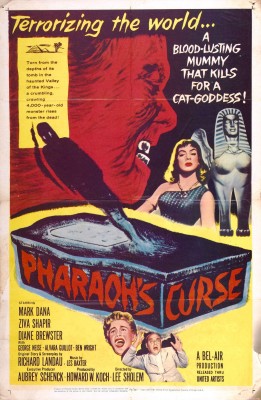| Reviews & Columns |
|
Reviews DVD TV on DVD Blu-ray 4K UHD International DVDs In Theaters Reviews by Studio Video Games Features Collector Series DVDs Easter Egg Database Interviews DVD Talk Radio Feature Articles Columns Anime Talk DVD Savant Horror DVDs The M.O.D. Squad Art House HD Talk Silent DVD
|
DVD Talk Forum |
|
|
| Resources |
|
DVD Price Search Customer Service #'s RCE Info Links |
|
Columns
|
|
|
Pharaoh's Curse
But it doesn't deserve to be. The picture is ambitious and atmospheric for its budget level, and in some respects it's vastly superior to Universal's more familiar Kharis the Mummy movies with Lon Chaney, Jr. Pharaoh's Curse admirably goes off in different directions compared to its predecessors while trying and often sustaining good atmosphere.
An MGM "Limited Edition Collection" manufactured-on-demand release, Pharaoh's Curse regrettably utilizes a full-frame transfer even though the movie clearly is meant for widescreen projection, probably 1.66:1 or 1.75:1. No extras.
In 1902 Cairo, with the British garrison under siege, Col. Cross (Ralph Clanton) orders Capt. Storm (Mark Dana) to rescue a stranded Anglo-American archeological dig in the Valley of the Kings before local Egyptians learn of their whereabouts. Sgt. Smolett (Terence de Marney) and Sgt. Gromley (Richard Peel) are to accompany Storm, along with Sylvia (Diane Brewster), American wife of the expedition's leader, Robert Quentin (George N. Neise). Along the way, mysterious Egyptian Simira (Ziva Rodann), who appears to be crossing the desert without adequate food and water, joins them. She's looking for her brother, Numar (Alvaro Guillot), now part of the archeological dig.
The band arrives just as the six others - Quentin, Numar, Frenchman Claude Beauchamp (Robert Fortin), German Hans Brecht (Kurt Katch), Scot Walter Andrews (Ben Wright), and medical doctor Michael Faraday (Guy Prescott) - have reached the burial tomb and are in the process of breaking the seal to a sarcophagus, brushing aside warnings of a curse upon all desecrators. After first removing a gold mask the scientists begin cutting away at the mummy's facial bandages underneath (Why?) but Numar suddenly collapses.
In a slight twist from such things, Sylvia has made the journey not to be with or to oversee the rescue of her husband, but rather to inform him in person that she's decided to leave him. Quentin immediately blames handsome Capt. Storm for this, but is less interested in his wife's welfare than his scientific discovery. Quentin isn't exactly a jerk, though clearly willing to be a little dishonest in order to carry on with his work.
(Mild Spoilers) More urgently, the mummy disappears and strange tracks resembling a cat appear near the sarcophagus. Later Numar, who's suddenly become aged and decrepit, with cracking, crumbling skin as if he were decomposing into dried mud, murders Gromley. The Pharaoh's curse is being carried out by a mummifying Numar. Simira, who comes and goes, takes the shadowy form of an Egyptian cat.
Phaorah's Curse, despite having been made a dozen years too late for the genre's "second-cycle" during the 1940s, and a wee bit early to cash in on its full-fledged revival (Hammer's The Mummy was just two years away), admirably adds a few new concepts to an overworked horror staple. It introduces or expands upon ideas not attempted in earlier films. For instance, the manner in which it acknowledges the tension between British and American looters and Egyptians outranged at the pillaging of these infidel scientists.
The monster is also a surprise. Possessing a local Egyptian, who may never have existed in the first place except to host the spirit of the royal retainer guarding the pharaoh's tomb, the man-mummy quickly becomes a wrinkle-ridden old man with rotting teeth and clay-like limbs. In one scuffle, one of the monster's arms breaks off like a fragile sculpture, and the scientists scrape it with a fork-like instrument. The flesh crumbles away like dried mud, revealing petrified (putrefied?) bone underneath. The revelation (not really a surprise) that Numar and Simira were actually spirits carrying out the pharaoh's curse and the decision by the survivors to reseal the tomb and walk away is nonetheless unusual and satisfying.
It's possible producer Howard W. Koch figured the less they spent on the good but no-name cast, the more money could by poured into the film's production. The unit did go all the way to Death Valley to shoot some of the (impressive) exteriors, unusual for such a cheap movie, and Bob Kinoshita's art direction of the tomb's interiors is likewise elaborate, with multiple ceilinged passageways, though the speckled "stone" walls aren't convincing, looking like they've come straight from the lumberyard. Another asset is Les Baxter's full-bodied score, which in the mummy scenes creates an unsettling effect possibly accomplished by playing some scoring in reverse.
Video & Audio
Pharaoh's Curse is presented full-frame even though shots are very clearly composed for widescreen. Seen 4:3, there's way too much room above the actors' heads, the edges of sets are revealed, etc., while zoomed in to 1.78:1 the compositions are almost perfect. The transfer is also oddly soft, as if filtered through cheesecloth, something most apparent in the day-for-night scenes. The region 1 encoded disc also offers good Dolby Digital mono audio, English only with no alternate language or subtitle options. No Extra Features.
Parting Thoughts
A minor but not insignificant discovery, Pharaoh's Curse is a fifties horror film undeserving of its almost total obscurity. Recommended, despite the inadequate transfer.
Stuart Galbraith IV is a Kyoto-based film historian whose work includes film history books, DVD and Blu-ray audio commentaries and special features. Visit Stuart's Cine Blogarama here.
|
| Popular Reviews |
| Sponsored Links |
|
|
| Sponsored Links |
|
|
| Release List | Reviews | Shop | Newsletter | Forum | DVD Giveaways | Blu-Ray | Advertise |
|
Copyright 2024 DVDTalk.com All Rights Reserved. Legal Info, Privacy Policy, Terms of Use,
Manage Preferences,
Your Privacy Choices | |||||||















